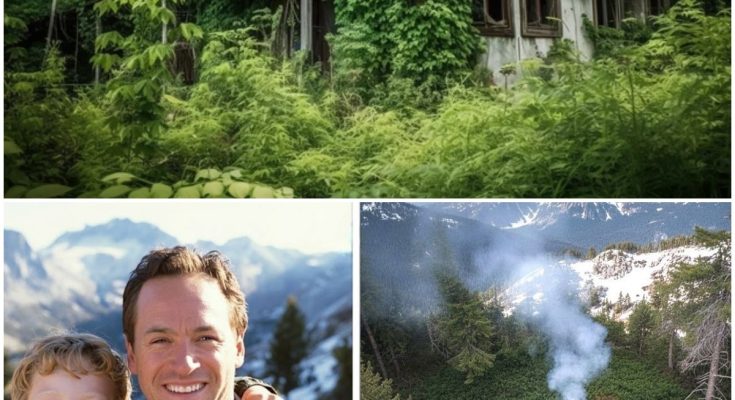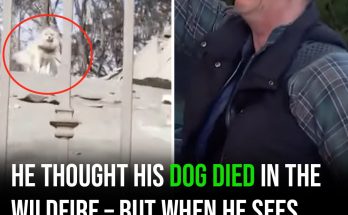October 12, 2006. The sun was setting behind the granite peaks of the Sierra Nevada, painting the sky in gold and purple. For Marcus Hoffman and his fourteen-year-old son Dylan, it should have been the start of a perfect adventure—a three-day camping trip in one of America’s most breathtaking wildernesses. Instead, it became the beginning of California’s most haunting mystery.
Marcus, a seasoned park ranger, had spent half his life in these mountains. He knew every trail, every hidden canyon, every river crossing that might spell danger for the unprepared. His son Dylan was already following in his footsteps: a straight-A student, an Eagle Scout candidate, a boy who could read a topographic map better than his GPS. They were prepared for anything. Or so everyone thought.
When they left their home in Bishop at dawn, Linda Hoffman watched them from the kitchen window, her heart swelling with pride and a faint, unexplainable worry. She’d seen them head into the wild dozens of times before. But this time, she held Marcus a little longer than usual. He smiled, promised to be back by Sunday night—“Dylan’s got school Monday, can’t be late!”—and drove off into the mountains, not knowing she’d never see them again.
They stopped for gas in Mammoth Lakes. The attendant remembered them: Marcus buying extra water and trail mix, Dylan poring over maps in the passenger seat. Everything seemed normal. Experienced hikers, perfect weather, a well-marked trail to Thousand Island Lake. What could go wrong?
At 12:47 p.m., they signed the Rush Creek trail register. “M. Hoffman + son, 3 days, Thousand Island Lake Area.” It was the last time anyone would see their names in ink.
When Sunday evening came and went with no word, Linda’s worry turned to dread. Marcus never missed a check-in. By midnight she was calling the Mono County Sheriff’s Department.
At dawn, search and rescue teams assembled at the Rush Creek trailhead. The Hoffmans’ blue Ford Explorer was parked neatly, keys in the ignition, windows cracked. Dylan’s homework folder sat on the back seat—a math test he’d never take.
Detective James Rodriguez, a veteran of dozens of missing hiker cases, arrived at 7 a.m. “No signs of struggle, no blood, no foul play,” he told his team. “They just… vanished.”
Search dogs picked up the Hoffmans’ scent along the main trail. For five miles, it was clear and steady, winding through alpine meadows and past Agnew Lake. Then, at mile marker 6.5, the trail simply ended. The dogs circled, whined, and refused to go farther. Their handler, Jim Collins, shook his head. “It’s like they walked off the face of the earth.”
Helicopters swept the forest canopy. Ground crews checked every switchback, every creek, every possible campsite. For seventy-two hours, over two hundred volunteers combed seventy-five square miles. They found nothing. Not a sock, not a scrap of food, not a single clue.
The search expanded. Maybe Marcus and Dylan had changed plans, taken a shortcut, or been forced off-trail by injury. Teams checked every backcountry site, every abandoned mine, every remote fishing spot. Still nothing.
By day five, it was the largest missing persons operation in Sierra Nevada history. The weather was perfect—clear skies, cool nights—but hope was fading. “We’re moving from rescue to recovery,” Sheriff Martinez announced at a press conference. “We haven’t given up, but survival time is running out.”
Investigators dug into every aspect of Marcus’s life. There were no secrets. No enemies, no financial trouble, no reason to run. Linda confirmed their marriage was strong. Dylan’s teachers described a happy, well-adjusted kid. His girlfriend, Emma Chen, said he’d been excited for weeks about the trip. His last text to her: a photo of his packed backpack, captioned “Ready for adventure.” She replied with a heart emoji. That was the last anyone heard from him.
The insurance policy was routine. Marcus’s cell phone went straight to voicemail—no signal in the backcountry. Credit cards hadn’t been used since Mammoth Lakes. There was nothing to suggest foul play or a staged disappearance.
Three weeks later, early snow closed the high country. Searchers were forced to suspend operations. “We’ll resume in spring,” Martinez promised. Linda refused to give up. Every few weeks, she hiked as far as she could, calling their names until her voice broke. She organized volunteer searches, posted flyers, pleaded with news crews for coverage. But as winter deepened, hope became a flickering candle.
Spring brought new searches, new technology—ground-penetrating radar, thermal imaging, drones. But the terrain was too vast, the clues too few. Detective Rodriguez kept the case open, but leads dwindled. Hikers reported possible sightings, but all proved false. Every year, the pain of not knowing grew sharper.
Seven years passed. The courts declared Marcus and Dylan legally dead. Linda used the insurance money to fund search efforts and support other families of the missing. She built a memorial website, organized annual hikes, and created a foundation to promote wilderness safety. But the one thing she wanted most—a sign, a clue, a body—remained lost in the mountains.
Eighteen years later, in September 2024, hope returned from an unexpected direction. Dr. Sarah Martinez, a wildlife researcher at UC Davis, was tracking a newly reintroduced wolf pack in the Sierra Nevada. Her drone, equipped with high-resolution cameras and infrared sensors, swept over a remote canyon twelve miles from the nearest trail.
At 3:42 p.m., Dr. Martinez spotted something impossible: geometric shapes half-buried in the underbrush. Tarps, sleeping bags, gear—clearly human, but not new. She called the Mono County Sheriff. Detective Rodriguez, now grayer but still haunted by the case, felt his heart race. Could this finally be the answer?
A recovery team flew in by helicopter, rappelling down into the canyon. What they found was not a tragedy of nature, but something far stranger.
Beneath an overhang of ancient rock, they found a meticulously organized survival camp. Fire pits ringed with stones, food containers hung from trees, sleeping areas lined with pine needles and old clothing. Everything suggested long-term habitation, not a desperate emergency.
Dylan’s red backpack hung from a branch, its contents preserved by the dry mountain air. Marcus’s park service jacket was folded near the sleeping area. The inventory matched Linda’s list from eighteen years earlier. But there was something else—a leather-bound journal, wrapped in waterproof material and hidden beneath a stone cairn.
The first entry was dated October 15, 2006, three days after their disappearance. The last was February 23, 2007—over four months later.
Human remains were found, carefully laid side by side. Forensic analysis found no sign of animal predation or violent trauma. But their location—deep in an unexplored canyon, miles from any trail—raised more questions than answers.
Detective Rodriguez opened the journal with trembling hands. The early entries were what he expected: Marcus documenting their hike, Dylan’s twisted ankle, their efforts to signal for help. They built fires, spelled SOS with rocks, rationed food. Marcus was confident at first, then anxious as days passed with no rescue.
But after a week, the tone changed.
*October 22, 2006. Day 10. Something’s wrong with the search. We see helicopters, but they never look in the right places. Dylan’s ankle is healing, but we keep hearing voices at night. Not rescue teams. Older, stranger. Dylan hasn’t mentioned them. Maybe it’s just me.*
Days later, both father and son heard the voices. Always at night, always from deeper in the canyon. Calling their names, but not like rescuers. Luring.
*October 28, 2006. Day 16. We investigated. Found structures built into the rock face—old, not mining cabins. Empty, but recently used. Symbols carved into the walls. I don’t recognize them.*
Then, a chilling turn:
*November 3, 2006. Day 22. We met them today. Seven people living in the settlement. They call themselves the Guardians. Their leader, Sarah, says we were brought here for a purpose. Our accident wasn’t an accident at all.*
The journal described the Guardians as a small, secretive group who claimed to have lived in the mountains for decades. They protected sacred sites, kept outsiders away, and believed that people were “drawn” to the mountains when new protectors were needed.
Sarah, their leader, told Marcus and Dylan that leaving wasn’t an option—at least, not until they understood their “responsibilities.” They provided food, shelter, and medicine for Dylan’s ankle. But they made it clear: the mountains had chosen them.
As weeks passed, Marcus’s entries shifted from skepticism to curiosity, then to something like acceptance. The Guardians taught them ancient survival skills, medicinal plants, navigation by stars. Dylan, always quick with puzzles, took to their lessons eagerly.
*December 1, 2006. Day 50. I understand now why the search teams couldn’t find us. The Guardians have ways of hiding this place. Sarah calls it ‘bending the path.’ Not magic, but knowledge—acoustics, camouflage, optical illusions. They know how to misdirect searchers, even dogs. Some have backgrounds in law enforcement.*
Marcus began to believe their isolation served a higher purpose. The Guardians showed him photos of sacred sites destroyed by tourists and developers. They spoke of ancient civilizations lost when their spiritual centers were exposed.
*January 25, 2007. Day 105. I’ve made my decision. Dylan and I will stay. The outside world has nothing to offer compared to the wisdom and purpose we’ve found here. The initiation is soon. We must let go of our former lives.*
The final entries were written in shaky, desperate handwriting.
*February 10, 2007. Day 121. The initiation ceremony is tomorrow. Sarah says it will be Dylan’s 16th birthday present, though his birthday isn’t until next month. We must drink a tea made from local plants. Dylan is excited. I have doubts, but it’s too late.*
The tea was a powerful hallucinogen. Marcus described confusion, memory loss, and terrifying visions. During the ritual, Dylan began convulsing. The Guardians had no modern medicine. By the time they realized something was wrong, it was too late.
*February 20, 2007. Day 124. Dylan is gone. The tea was too strong, or maybe his body couldn’t handle it. He died in my arms, far from home, because I believed their lies.*
The last entry:
*February 23, 2007. Day 127. This is my last entry. I can’t live with what I’ve done. The Guardians say Dylan’s death was a necessary sacrifice. But I know the truth. I killed my son by believing their insane philosophy. Linda, if you ever find this, know that we loved you. None of this was your fault.*
Forensic analysis confirmed Marcus’s account. Both father and son had high concentrations of plant alkaloids in their systems—powerful hallucinogens. Their deaths were not the result of exposure or accident, but of the Guardians’ rituals.
Detective Rodriguez closed the journal and looked out over the camp. The Guardians were gone. Their settlement abandoned, their hiding places empty. But their sophisticated knowledge of concealment—camouflage, misdirection, even manipulation of search and rescue protocols—meant they could be anywhere in the vast Sierra Nevada.
The case of Marcus and Dylan Hoffman was closed, but the nightmare was not over. Somewhere in those ancient mountains, the Guardians were still out there—waiting for the next lost hiker to wander into their web.
The Sierra Nevada kept Marcus and Dylan Hoffman hidden for eighteen years. Their story is not just a tragedy of nature, but a warning—a testament to the power of isolation, manipulation, and the human yearning for purpose. Marcus’s journal is a chilling record of how even the strongest bonds can be broken by those who prey on the lost.
Linda Hoffman finally has her answers. But closure is a myth. The mountains that Marcus loved became his family’s tomb—and the shadows that claimed him remain, silent and patient, in the wilderness.
If you ever find yourself alone on a remote trail, and you hear voices calling your name from the darkness, remember the Hoffmans. Some secrets are meant to stay lost.



